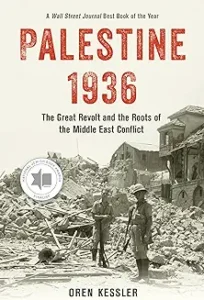Palestine 1936: The Great Revolt and the Roots of the Middle East Conflict by Oren Kessler 2023
Kessler, a newspaper reporter, has written an important book which provides detailed facts and analyses about how the Middle East was positioned prior to WWI and how it has become the focal point for world conflict since then.
In prose that is both clear and compelling, I learned of the details of how the Zionists led by Herzl and Weitzmann, the British with Balfour, McMahon, Churchill, McDonald, Peel and Woodward, the Palestinian Arabs with Grand Mufti HajjAmin al-Husseini, George Antonius, and Musa Alami, and the pan-Arabists like King Faisel and King Abdullah met, fought, argued, and ultimately went to war over this thin sliver of land between the Jordan River and the Mediterranean Sea.
The book abounds with personal portraits and accounts of meetings, conferences, conversation, and commissions all of which failed to resolve the foundational conflict—the desire of Europe’s Zionists to return to their Biblical homeland and to escape the pogroms of Eastern Europe and the Holocaust of Nazi Germany on the one hand and on the other the unyielding demands of the Palestinian Arabs to prevent the formation of a Jewish majority and remain in control of their land.
More than one hundred years after the Balfour Declaration indicated Britain’s commitment to support a Jewish homeland in Palestine, the events of October 7, 2023 reflect the failure to square this circle. Radical Palestinians in the form of Hamas refuse to accept the legitimacy of Israel as Hajj Amin did when he boycotted the Peel Commission and rejected the UN partition of 1947. On the other side, right wing Greater Israel supporters refuse to cede any land and reject the possibility of a national Palestinian state and the right of return.
The Great Arab Revolt in 1936 is cited as the pivotal point when Arab anger and frustration boiled over into random killings of civilians and when Jewish military capacity in the Irgun and Hagganah first developed. Reading about the random killing of both Jews and Arabs (not to mention the loss of dozens of British soldiers’ lives as they tried to maintain order), I could not help but be reminded of what is happening there today.
There are hundreds of books about the Israel/Arab conflict, but this one should rank high on anyone’s list who wishes to understand the background. It is all about population, inward immigration of Jews, and the return of millions of Palestinians who fled the 1948 war. In 1914, Jews represented 7% of the 100,000 people in Palestine. By 1939, they were between 35-40%. Today they are 7 million of the 9 million people in Israel. There are 2 million Palestinians in Gaza, 3 million in the West Bank, and another 10 million plus in the Arab Diaspora. How does Israel remain democratic, Jewish, and peaceful in the face of this math? And when does the Arab world accept the legitimacy of the Jewish state founded by international agreement 75 years ago?
The Brits couldn’t solve this dilemma during the Mandate (1918-1947); the UN couldn’t solve this dilemma in 1947-48; and the wars of 1956, 1967, 1973, and 2023 have failed to resolve the question. I am not optimistic that it will be solved in my lifetime.
This is an important and readable book that is important for anyone interested in this complex question beyond the rhetoric and violence on the two extremes.



